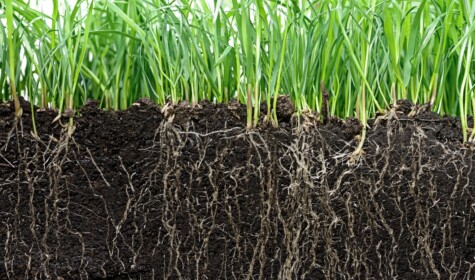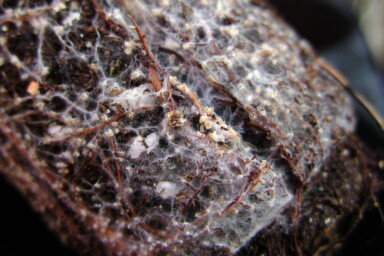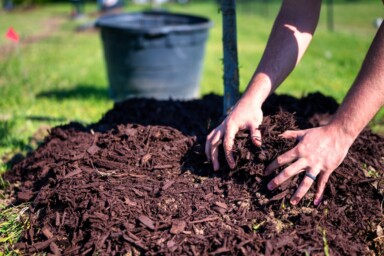Earlier this year, US soil microbiologist Elaine Ingham, of Soil Foodweb Inc. fame, caused several gasps at the Oxford Real Farming Conference with her controversial lecture, ‘The Roots of your Profits’. I recommend anyone interested in joined-up thinking about health to listen to this and view her slide presentation.
Put bluntly, Ingham’s message is that if you are interested in health, you have to be interested in soil. This lecture, and her work in general, brilliantly explains why.
Time to take a deep breath, prepare to have conventional thinking about soil turned on its head and find out why soil biology should matter to you.
Soil vs dirt
As most of us have realised, soil is not merely a prop for plants or ‘terra firma‘ for the biosphere; it is an infinitely complex underworld and inter-dependent web of micro-organisms such as bacteria, fungi, protozoa, nematodes and micro-arthropods to name a few.
It is this hidden world that allows our planet and our society to thrive. It is every bit as important to our health as breath itself.
But far from nurturing the soil that feeds us, agriculture often destroys it. Every time the soil is disturbed, or artificial fertilisers and pesticides are applied, soil life is killed and soil structure compromised.
Soil erosion, the leaching of water and nutrients, anaerobic conditions, pests and diseases all follow. The system gradually collapses and eventually the soil – now bereft of soil life – is degraded so much it becomes mere dirt.
It’s a self-perpetuating cycle of destruction, and farmers then have to devote their energy to dealing with the destructive knock-on effects.
Myth bashing
For Ingham, agriculture should be the art of nurturing soil life. It’s essential to understand what makes the life in soil tick – and conversely what destroys it – as well as how to manage soil life so it works to overcome the challenges that producing food presents. Get your soil biology right – ensuring the ‘good guys’ (aerobic micro-organisms) flourish and are in balance – and the rest falls into place.
Forget the latest farm app: the most essential piece of equipment a farmer or grower can have is a microscope. And the one skill she or he needs above all else is how to make aerobic compost and compost teas. It is these that contain the necessary microorganisms for soil health. Applied correctly, this is the only magic bullet you’ll ever need. It’s as simple as that.
But Ingham also goes further. She has no time for wasting money on soil tests, pointing out that during her lifetime the number of plant nutrients considered to be essential has increased from 3 to more than 40. Who can say what a plant needs, except the plant itself?
Applying this mineral or that fertiliser, Ingham says, is also a waste of money. Assays of plant tissues reveal that the nutrients present bear no relationship whatsoever to any soluble artificial nutrients applied. A plant requires all nutrients to a greater or lesser extent, and only it knows what it needs and when – the trick is having all those nutrients in a bio-available form in the soil at all times.
She also blows away the myth of pH, the measure of soil acidity or alkalinity. Since when, she asks, has nature said a pH 6.5 is ideal for crops, when they grow successfully in ranges from 5.5–11? Soil pH varies so widely even along a root hair that an average value is meaningless. It isn’t the soil pH that needs analysing, it’s the soil’s microbial life.
Even more controversially, Ingham points out that all soils on the planet have enough (inorganic) nutrients locked up in their mineral particles (that is, particles derived from rocks) to feed plants for the next 10,000 billion years. What?!
The only reason the Green Revolution worked is that it fed dirt, not soil. Sustainable intensification? Forget it. It won’t work because it can’t: it still relies on the chemical inputs that destroy soil life. Get your soil biology right, and you don’t need to spread manure, rotate crops or till soil. (At this point, even the organic farmers at the Oxford conference winced.)
Theory into practice
Ingham has spent the past 40 years putting her knowledge into practice and training farmers, growers and gardeners to become soil doctors. She has achieved impressive results. Pasture grasses, for example, have increased rooting depth and protein content has gone up from 5%–25%.
But to understand why her followers achieve the results they do requires a basic primer in the evolutionary relationship between plants and soil life.
Nature’s elegant solution
Plants use sunlight to make sugars; they then send most of these to their roots as exudates (substances that ooze out from plant tissue) – or, as Ingham puts it, they deliver ‘cakes and cookies’ to the soil for aerobic bacteria and fungi to feed on, encouraging them to amass around the roots and prosper.
These ‘good guys’ have three important functions: they form a protective army to fight off the ‘bad guys’ (anaerobic micro-organisms responsible for disease); they contain the necessary enzymes and acids to break down and transform inorganic nutrients in soil particles into organic nutrients suitable for plants; and they play a critical role in the formation of soils’ structure, which is necessary for water retention, preventing the leaching of nutrients.
Why, then, do you need an armoury of chemicals when nature has already provided a ready-made solution?
Why life needs death and death creates life
At this stage, the nutrients that plants need are still locked up in the microorganisms, and are only released when the latter die. To enable this, nature has evolved predators – creatures that eat other creatures for their food – to create food chains and thus ensure constant nutrient recycling.
In this case, the predators are protozoa, which eat bacteria, nematodes and micro-arthropods, which eat fungi. These predators then excrete the excess nutrients – now bio-available – into the surrounding soil, creating a constantly replenishing supply of food around the plant roots, where they are needed. Clever, isn’t it?
We can see why predators are necessary for plant life, and why we are better working with the fundamental rules of nature than against them. As Ingham has pointed out, Mother Nature doesn’t need human beings, but we need Mother Nature. It’s a one-way street. This is why we have to go back to soil biology to reform agriculture from the ground up. As she says, it’s the only way forward if human beings are to remain on this planet.
Compost: the key to sustaining life
The evolution of plant life is intimately bound up with the soil biology prevalent during its development. The types and ratios, for example, of bacteria, fungi and other microorganisms determine what crops will flourish, and enable evolutionary succession to take place.
It follows that what grows where is a good indicator of your soil biology; and it provides clues to where the imbalances might be in the soil, which are preventing you from growing the best crops you can. Again, the simple, quick and easy way to fix this is to ‘inoculate’ the soil with the correct compost.
This is why compost is the nearest farming gets to a cure-all: it holds the key to sustaining life. It’s cheap and easy, and as soils become self-sustaining, the problems go away and crops are more productive – they become stronger, healthier and more nutritionally dense. No wonder, then, that Ingham is not popular in conventional agriculture or the chemical industry.
It’s more than a gut feeling
As Ingham’s lecture illustrates, the vital connection between healthy soils, plants, animals, people and planet is not mere rhetoric but an evolutionary truth. Patrick Holden, Chief Executive of the SFT, has also noted that the parallels between soil and human health are too obvious to ignore. Just as the ‘good guys’ in the soil promote and protect soil health, so the beneficial microbial flora in our gut (our microbiome) are essential for promoting and protecting our digestive health, and boosting our immune system.
But guess what? Antibiotics, antibacterials and antifungals impact negatively on our microbiome. One can only wonder, then, what a lifetime of food additives, junk food, pesticide residues, degraded food produced from chemical farming and even GM ingredients do to our internal ‘soil life’?
This is why the quality of the food we eat, and how we produce it, is so vital. And it is why we need to take Ingham and other whistleblowers seriously when they warn us that the quality of our soil affects the quality of our food and its fundamental ability to nourish us.






